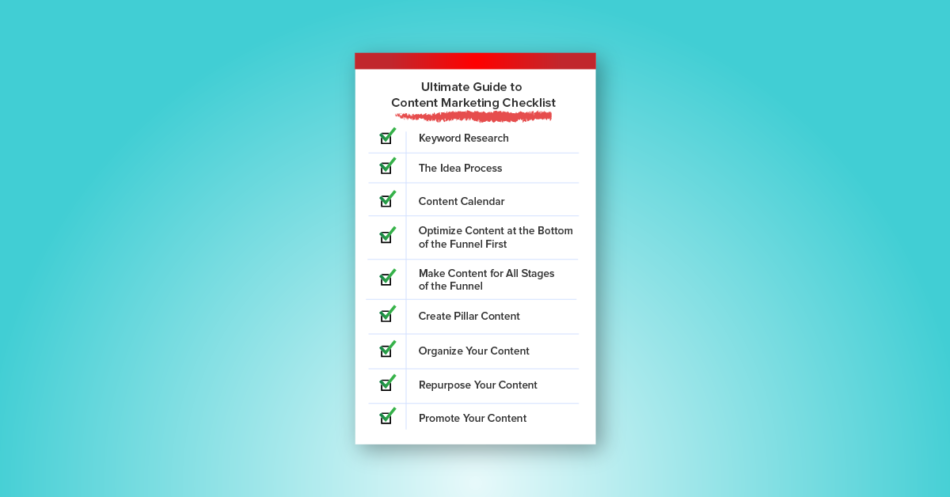
The Ultimate Guide to Content Marketing
03/31/21
Content
Content marketing has become a buzz phrase – you hear it all the time, know it’s important, but may not know how to do it.
Today we’re going over everything you need to know to create great content, build an audience of fans, and win more customers over time.
Lugh Studio’s Ultimate Guide to Content Marketing
Table of Contents:
- What is Content Marketing?
- Why is Content Marketing So Important?
- Different Kinds of Content Marketing
- How to Create Successful Campaigns
- Lead Generation & Measuring Success
- Tools & Learning Resources
What is Content Marketing?
Content marketing, according to the Content Marketing Institute, is the act of “creating and distributing valuable, relevant, and consistent content to attract and retain” new customers.
So what exactly is content?
Well…just about anything. Content can be anything from a blog post to an infographic to an informative video.
The main criteria, as we will see below, is that your content is somehow valuable or educational to the audience that is consuming it.
While content marketing has been around as long as we’ve been marketing, it’s seen a surge in importance in the digital era. In fact, over 75% of businesses say content marketing is a fundamental part of their marketing plan.
In short, in 2021, content marketing IS marketing.
Why is Content Marketing So Important?
We live in a time of abundance.
Whether you’re looking to purchase an expensive home or cheap t-shirt, it’s never been easier to do research. A huge amount of information is accessible at the click of a button.
With this easy access to information, from social media sites to millions of online reviews, the power is now in the consumers’ hands.
This means that it’s never been more important to stand out.
It’s no longer enough to “get the job done.” In the modern economy, you have to be different somehow. And in the 2020’s, the way towards “difference” for many companies is through content.
Modern marketing looks very different than it used to.
Whereas companies used to focus exclusively on outbound marketing, the focus has shifted towards inbound. Shoving your company’s advertisement in front of a potential consumer is no longer enough.
Helping them, educating them, and providing value before they ever make a purchase is the direction many companies have gone.
And how do you do this?
Through valuable content. Content marketing connects you with your audience. With a content plan that is devoted to serving your audience, you start to gain their trust. The value that you provide, over time, deepens your relationship.
And once you do that?
It’s much easier to sell to them later on. Content marketing is not just about helping people for nothing in return. Instead, it’s a very clear driver of a company’s bottom line.
A robust content strategy also positions you as an authority. Just as a content strategy builds trust with your audience, it also shows them that you actually know what you’re talking about.
Good content is your chance as a company to show people what you know. After all, people want to be confident in their purchasing decisions.
What better way to do that than to teach them something?
Lastly, content is essential for SEO. While SEO is a huge topic in itself (and certainly one that deserves your attention), for now just know that SEO is indeed important, and that content plays a huge role in your search engine rankings.

Different Kinds of Content Marketing
Of course, there are plenty different forms of “content creation.” Which one you choose will depend on a variety of factors such as what your business is, what your interests are, and how much time and budget you have to devote to your content strategy. You need to ask yourself these questions before making a content marketing plan.
The most important criteria of content is the value that it brings. This can either be educational, entertainment, or both.
There are four main types of content you can create. Keep in mind that there is a lot of overlap here, and most content plans implement a mixture of all four.
Written Content: The main example of this is a blog where you share your expertise and try to help your audience. However, written content can encompass much more than that. Check out this list for some more ideas.
Image Content: While the example that immediately comes to mind is Instagram, this type of content can be much more diverse. Images like infographics not only make your content more engaging, but are super helpful to your audience. Take a look at this list for more inspiration.
Video Content: Video is increasingly becoming the norm in the content world. In fact, some experts estimate that video will be the dominant form of content by 2022. Creating high quality video can be a lot of work – here are some ideas for video content.
Audio Content: One obvious example here is a podcast. Audio content not only explains concepts better than writing can, but is convenient for your audience to be able to listen on-the-go. If you want to learn more about audio, check out this guide.
How to Create Successful Campaigns
Let’s now dive into strategies for improving your content marketing efforts. Keep this in mind: content marketing is constantly evolving. What worked yesterday might be outdated by tomorrow. That’s why it’s so important to keep constantly learning.
Here are some steps to becoming a content marketing rockstar.
1) Keyword Research:
If there is one thing to master, one skill that would give you the biggest bang for your buck, keyword research is it.
It’s not enough to just make content, you have to make sure you’re making content people are actually searching for – that’s where keyword research comes in.
In addition, it’s useful to take into account user intent. Google’s algorithms are getting increasingly complex. This means that a simple Google search of your keyword gives you a good idea of the sort of content you should be creating.
2) The Idea Process:
Once you have done some keyword research, it’s time to actually come up with content ideas – meaning the format & theme that your content will take.
Suppose you own a cat food business. You did your keyword research and discovered that you can realistically rank for the phrase “healthy cheap cat food.”
Now it’s time to figure out how you will make that piece of content. Will you make an infographic about how to choose healthy cheap cat food? Or maybe film a video reviewing the main brands?
You are only limited by your own imagination. Creativity is important here, check out our post on coming up with content ideas for inspiration.
3) Content Calendar:
The importance of a content calendar can’t be understated. In fact, there seems to be a direct correlation between the frequency of your content and how successful you are with your overall content strategy.
Simply put, consistency is essential – it’s how you:
- Win the trust of your audience
- Keep yourself accountable
- Continually demonstrate your expertise
4) Optimize Content at the Bottom of the Funnel First:
The “buyer’s journey” looks a little different these days. With easy access to information and thousands of your competitors’ products at their fingertips, anybody can enter any stage of the funnel at any time.
That’s why the bottom of the funnel leads are so important. These are the people that are the closest to buying. They are already “warm” and close to pulling out their wallet – they just need a little more convincing.
5) Make Content for All Stages of the Funnel:
This step goes hand-in-hand with the previous one. Different people at different stages want different things from your company. Somebody just discovered your company? Blog posts might be an option for developing that relationship.
They know you and are now at the stage of comparing you with other solutions? In this case, it’s important to have convincing product comparison charts.
Simply put, most people are not ready to buy within the first 7-10 contact points with your business. That’s why you have to educate them!
Check out this guide for best content creation practices.
6) Create Pillar Content:
Pillar content, sometimes called “power posts,” are exactly what they sound like: pillar pieces of content. They are well-researched, super in-depth, and usually at least 2,000 words long. The form they take is quite often blog posts.
Pillar content is important because it has a lot of SEO power to it. These are the pieces of content that people are often likely to link back to and position you as a master of your topic.
Very often, companies and organizations produce “Ultimate Guides” to up their pillar content game — just like this one.
While consistent, shorter content is essential (remember: consistency is key), definitely consider creating pillar content as well.

7) Organize Your Content:
Once you’ve created content, you still need to make sure that it’s well organized.
The organizational structure is important for two reasons. First, it helps search engines to better understand your website. This increases the likelihood that you rank highly and more users are brought to your site. Second, a well structured content plan increases the quality of the user experience. This makes it easier for site visitors to find exactly what they’re looking for.
Check out the “hub and spoke” model for ideas on organizing your content.
Just remember this: a bunch of great content doesn’t bring nearly as many results if it’s unorganized.
8) Repurpose Your Content:
Making brand new content takes time. Thankfully, you don’t always have to. The fact is, you likely already have “assets” built up. This can be anything from a blog post you have written before implementing keyword research or interviews you have recorded in the past.
In this case, there are no rules against “repurposing” what you have. This could be turning a video into a blog post, or adding some visuals to a written piece of content and making it into an infographic.
Repurposing content not only gives you more pieces to work with, but ensures you are making something that all members of your audience can appreciate.
9) Promote your content.
Your job isn’t over once you’ve created content. In fact, a lack of a coherent promotion strategy is one of them main reasons why companies fail with their content.
While good SEO is how you get found organically, it takes time. That’s why content promotion is so vital.This could be anything from sending post updates to your email list to promoting new videos on social media sites.
Check out this guide to promoting your content the right way.
Lead Generation & Measuring Success
The main purpose of content marketing is to gain more customers. That’s why lead generation is so important. While lead generation in itself is a huge topic, the two go hand in hand.
One of the easiest ways to generate leads is to ask users to sign up for something. This could be anything from your email list to your Youtube channel. Keep in mind that certain channels have a much higher ROI for leads than others.
That’s why we created our ultimate guide to email marketing.
Once you have turned a “content consumer” into a lead, it’s time for lead nurturing. This consists of building up the relationship with your leads over time and gradually opening them up to becoming a customer.
Check out this guide for more information.
It can be difficult to measure the success of content marketing. Inbound marketing is more “long term” than outbound marketing, and even though it is often more effective, it can take longer to see results.
These are some major KPIs you should keep track of:
ROI
Conversion rate
Subscribers
Views
Traffic growth
Average value of lead
Downloads
Bounce rate
While these are all important, make sure to think about what you need to know.
Which KPIs are relevant to your own content marketing efforts? It’s much better to become an expert at measuring a few than having basic knowledge of them all.
Check out this list of content marketing KPI’s.

Tools & Learning Resources
Like I said before, content marketing is always changing. While the fundamental value of content marketing is here to stay, best practices and things to avoid will always be changing.
That’s why I’ve gathered some of the best tools and resources you can use. These will not only help you with your own content marketing efforts, but keep you continuously learning about the field.
Tools:
BuzzSumo: Figure out which topics are trending.
Google Keyword Finder: Conduct keyword research for free.
Evernote: Organize all your ideas and drafts in one place.
Canva: Design and edit pictures for your content.
SEMrush: Gain valuable SEO insights.
Learning resources:
Content Marketing Institute: The name says it all! This website is an excellent resource to learn about content marketing, regardless of whether you are entry level or relatively advanced.
HubSpot: HubSpot gives you a variety of tools to work with. They also have an excellent content marketing strategy, which you would be wise to learn from.
Search Engine Journal: Your go-to guide for everything related to SEO. No use creating great content if it never gets found in the first place.
Ahrefs: Not only one of the best keyword research tools out there, but an excellent blog as well.
Conclusion
Content marketing is more than just a passing fad.
In many ways, content marketing is marketing. Provide value, educate and entertain, and give your audience something that they can use… all before asking for a dime.
This is the essence of content marketing. Remember the golden rule of “value first,” and you can’t go wrong.










